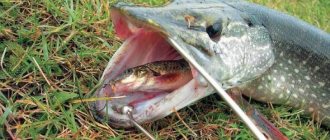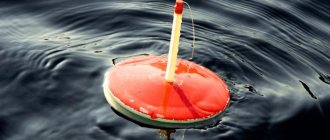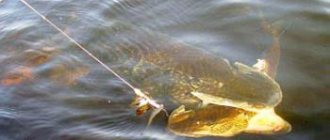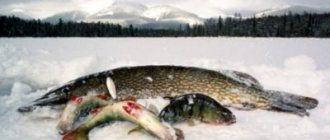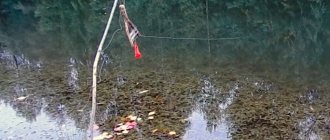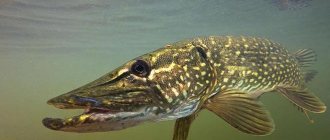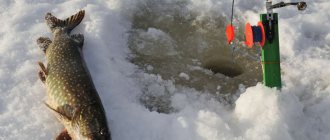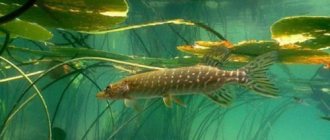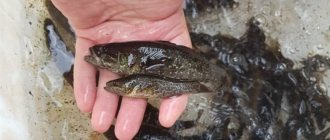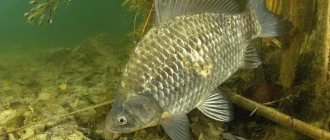What is a winter zherlitsa
A zerlitsa is a fishing tackle designed for catching predatory fish using live bait. Depending on the season, summer or winter type devices are used. The latter are a circle or disk, to the base of which is attached a signaling device with a red flag and a high stand with a spool of fishing line, 0.3–0.35 mm thick. The zherlitsa is a fairly simple device in terms of design, but it is highly efficient and effective.
In addition to the disk and reel with fishing line, the following elements are included in the package:
- sinkers - use oval-shaped weighting elements weighing 10–15 g. When fishing in deep reservoirs, select sinkers weighing 20 g;
- hooks - they must be as strong as possible to support the weight of a large fish.
Fishing with the described gear is reminiscent of spinning fishing, but in the first option a leash is often used, which allows you not to miss a large predator. In this type of fishing, live bait is used as bait - roach, rudd, roach or ruff.
When purchasing a ready-made zherlitsa in specialized stores, experts advise paying attention to the following aspects:
- It is better to give preference to a plastic reel;
- the movement of the reel should be slightly difficult, which will avoid tangling of the fishing line;
- it is better to choose a signaling device (made of metal) whose length does not exceed 50 cm;
- the signaling device must be equipped with a flag of a bright, rich color;
- the alarm must be flexible, but at the same time strong enough not to react to the movements of live bait.
Important! The best option is considered to be a compact, fairly lightweight vent, which can be installed quickly and without problems and provides good visibility.
Equipment components
Let's look at the necessary fishing accessories to assemble a rig for ice fishing. To create the equipment you will need fishing line, sinkers, leashes and hooks. All these elements can be connected into various schemes. Each specific condition requires its own “caliber” of equipment.
fishing line
Rigging a girder in winter begins with selecting a working fishing line. Which line to choose in winter for girders? It all depends on the type of predator and its size. The main fishing object is pike. The thickness of the fishing line for the girder in winter for toothy ones in regions where there is a lot of it (Siberia, the North, remote places) is chosen to be larger - from 0.4 mm. In the middle zone and places with high fishing pressure - about 3-0.35 mm. This is enough, but the toothy one may not bite on a thicker one.
For pike perch, trout, perch or rotan, a diameter of more than 0.35 mm does not make sense. Thicker fishing line has a strong memory; it curls up and gets tangled when unwinding. A larger trophy can simply break a thinner thread. Therefore, the optimal diameter for any conditions is 0.25-0.35 mm.
The length of the fishing line on a winter fishing line depends on the depth of the reservoir and fishing conditions. Meter-sized pieces are also suitable for flags for rotan. For toothy ones, where unwinding is important, the amount of fishing line on the girders should allow the predator to reel out as much as necessary. In this case, there should be a supply of fishing line left on the reel. Usually 15-20 meters are reeled in (for fishing in the coastal zone). At depths 30 m or even more may be needed. How many meters of fishing line to wind on the girder in winter must be decided based on the conditions where the installation is usually made. In snags, the supply is limited so that a predator cannot take the equipment into the wilds. When fishing in snags, the equipment itself requires special equipment for quick hooking, since long unwinding cannot be allowed (more on this later).
How to tie a fishing line to a fishing reel? This node is worth paying attention to. An active predator, if a bite is not noticed in time, can unwind the entire stock and tug hard. And the attachment point to the reel must stand. Reels for girders are usually solid and do not have special hooks or holes for this. Therefore, the fishing line is wrapped around the reel and tied with a regular fishing self-tightening loop or an arbor knot.
No less important is the question of which line is best to put on the girders in winter. The best option is special winter fishing lines, fluorocarbon or fluorocarbon. They have low elongation and memory, are more resistant to microdamage from ice, and do not lose their properties in the cold. Properly selected fishing line for winter fishing rods is the key to ease of working with fishing gear. Braided wire is not used on the vents - it is inconvenient to work with in the cold. A regular monofilament nylon fishing line is used, only for winter use.
Sinkers
What kind of weight should I put on the winter rack? Most equipment uses a sliding version. Blind weights are only needed when fishing in the current for a retractable leash. Various options are suitable for the form:
- Ball,
- Olive,
- Cone,
- Double cone,
- Cylinder.
On rough rigs in places where predators are not particularly picky, any shape, heavy weight up to 10-15 grams will do. In the middle zone and on light rigs, it is better not to use a sinker of more than 5 grams. And the point here is no longer in the predator itself, but in the live bait. With a light load, live bait better retains its survivability, having the opportunity to rise into a microlayer of water richer in oxygen content. Affects the choice of weight of the sinker for the winter bait and the size of the live bait. In the case of trophy fishing using a fairly large live bait as bait, the weight of the sinker should be increased.
For passive and cautious fish, you need to use olives and cones with the point down - to reduce resistance when pulling. You can put a rubber stopper on the main line in front of the leash. This trick makes it possible to lift the load higher on the rig, giving more freedom to the bait fish (in places clear of snags or underwater vegetation).
Leashes
For jigging for pike perch, perch or trout, special leashes do not need to be used. The hooks are tied directly to the main line. Another thing is the toothy pike, which can easily cut the equipment. For active fish, you can use ordinary metal leashes - made of string, stranded, nichrome, Kevlar, titanium or tungsten. Especially in places where pike are not capricious. However, the use of transparent leader materials or fluorocarbon significantly increases the likelihood of a bite. Even just a double line already reduces the chance of biting many times over. The main thing with such a leash is to make sure that when fishing it does not get caught by the so-called pike whiskers. In this case, the toothy one is more likely to cut the rig. Often fishermen use twists from fishing line or homemade braids.
If the pike bites actively, on the first and last ice, then it is better to use reliable metal leashes. In the dead of winter you should switch to transparent ones. A single principle works here: in the first ice conditions, strength and reliability are more important, and in the dead of winter, invisibility is more important. If you make your own leash, you will need swivels, clasps and winding rings. You need to select high-quality fittings so that they do not fail at a crucial moment.
Hooks
The type and size of the hook is selected depending on the equipment. For pike perch, for example, ordinary hooks are often used (when fishing with fry or sprat). For perch - small trelets or doubles. The range of possible options for the toothy one is the widest. The size of the hook is selected based on the size of the baitfish. Most often, tees or doubles are used on vents. Triple ones are more grippy, but this also has a downside. In the dead of winter, a predator may not grab the bait immediately, but tug at it, and, having impaled itself on the sting of the tee, throw it. The double hook is convenient to remove from the leash loop for attaching live bait through the gills. An important point is the quality of the hooks. They must be strong and sharp and not bend under load. You can’t use rusty ones - fish can sense the smell of iron oxide very well in water and do not like it.
How does the girder work?
The operating principle of a winter type vent is simple. As mentioned, the device is equipped with a spool of fishing line and a signaling device with a flag. When installing the tackle, the flag is fixed under the reel. When the bite begins, the reel makes rotational movements and the flag shoots.
When installing, experts do not recommend setting the vents to their maximum depth. It is better to bury the sinker at half-water or a little lower, since in this position the predator will notice the bait faster. If the bait is located at the very bottom, then pikes that are weakly active in winter may not see it.
Video: Winter zherlitsa
It is very important to pay attention to the bait. Its size should be small, about 10 cm. The bait fish must be hooked onto the dorsal fin, while being careful not to damage the fish’s spine, since it will quickly die and you will have to “put on” a new bait. After installing the gear in the required place, the fisherman can only wait for the signal to appear. However, even after the flag has “shot”, you should not make a sweep. Experienced fishermen give the predator time to play with the bait and swallow it deeper. As soon as the line is completely unwound, you can pull out the fish.
How to fish with zherlits: tactics and techniques for winter fishing for pike perch with zherlits
For winter fishing, a pike perch pole is an effective tackle if you install it in the right place and act correctly at the moment of the bite.
Tactics
A fisherman on a pond must select a fishing zone. Then you need to drill the required number of holes and study the depths and topography of the bottom. This can be done using a weight tied to a fishing line, if you know how to measure the bottom correctly. But you can also use an echo sounder. It is best to place the zherlitsy in quiet places: along slopes, edges, depth changes, near flooded snags, along ditches. If fishing is to be done in a large hole, then the gear is placed evenly throughout the water area. Now all you have to do is wait for the bite alarm attached to the reel to go off.
Hooking and landing
If the fish is hungry, it will swallow the bait with a hook immediately; if it is full, it will first grab the bait and swallow it whole after some time. Therefore, you need to give it a few seconds to swallow, but not too much, otherwise it will come to its senses and release the bait. After the bite, wait about 30 seconds and then hook.
They catch pike perch quickly and evenly. It is important not to give him the opportunity to swim far from the hole.
Types of winter girders
There are many different models of winter vents, but they can all be divided into categories, depending on the type of installation:
- vertical or horizontal;
- above-ice and under-ice.
Each of them has its own advantages and disadvantages. Descriptions of the most popular models are presented below.
On the platform
The most common models of winter gear are platform girders or flags. Their design consists of a rectangular, square or round platform, equipped with a special slot for making fishing line, fixing elements for a flag, and a reel with a stand. In this case, the flag is a long steel spring, at the end of which a piece of bright red fabric is attached. The platform device is placed directly on the hole.
- It has a number of advantages:
- simple, easy to install;
- low cost;
- allows you to completely cover the hole from the sun, thereby not frightening the predator with too much lighting;
- the platform makes it possible to prevent rapid freezing of the hole.
- The girder is not without some disadvantages, among which fishermen note:
- fairly large dimensions of the device;
- fragile unit for fixing the coil to the base;
- sometimes the gear may freeze into the ice, which makes dismantling it labor-intensive;
- at temperatures below -10°C the fishing line freezes to the ice.
Reworking the flags
Flags are specifically designed for pike fishing. Their main parameter, influencing the quality of the fishing process, is considered to be unwinding.
That is why experts advise making some “upgrade” of the device:
- disassemble the coil, carefully grind off all the burrs on the mounting hole, adjust the tightening force;
- If necessary, install washers and replace the nuts with wing nuts.
Find out more about the features of a motor drill for winter fishing.
The most important thing when modifying the girder is working with the coil. The mechanism must be adjusted in such a way that the specified component of the equipment rotates easily and evenly, without jerking, and at the same time slows down slightly and does not spin out of inertia. For more convenient observation of unwinding, it is recommended to make a bright stripe on the surface of the reel from the middle and along the radius. To make the reel easy to turn with gloves, the handle should be strengthened.
In addition, the base is subject to slight modification:
- the slot for the fishing line is also carefully polished to remove burrs;
- the “sole” is glued with any heat-insulating material that will protect the structure from freezing;
- foam rubber is attached to the stand.
Additionally, for reliable fixation, it is recommended to glue and stitch the flags, replace store-bought fabric with silk, which has high strength and is more noticeable in winter.
You will be interested to know about a homemade underwater camera for winter fishing.
Vertical on a rack
A rack-shaped rack is an excellent option during heavy snowfall.
- It has many advantages:
- small size, simplicity and ease of transportation;
- the reel is firmly fixed to stands made of any material: plastic, wood, steel;
- Can be used in open water, tied to a stake.
- Among the disadvantages of “verticals” are:
- unstable position;
- freezing of fishing line into ice at low temperatures;
- possible freezing of the line to the reel.
Tripod
It is a type of winter girder in the form of a structure on three supports, between which a reel with fishing line is attached in the center, and a flag is placed on top.
A tripod has higher stability than a stand, but many anglers note it:
- poor reliability;
- lower stability than platform ones;
- complex design;
- lack of protection of the hole from freezing.
As a rule, a tripod is used during thaws and during the “last” ice.
Horizontal on the crossbar
A horizontal vent on a crossbar is a device in the form of a rail with a reel and a flag on a spring, which is attached between two brackets with a loop made of fishing line. Such gear is made independently; they are excellent as supplies.
Important! For active fishing, American horizontal girders are used, working according to the principle described above. However, they have very complex designs and are quite expensive.
For active fishing, such devices are not very convenient:
- there is no full-fledged reel;
- the unwinding line has to be laid out on ice, as a result of which it can freeze;
- Idle flag activations often occur;
- there is no protection against freezing of the hole.
Changelings
The functioning of the gear-shifters is based on the principle of leverage: when biting, the brightly colored opposite side of the device rises up. Hence the name of the girder. Such devices are equipped with a reel, but do not have a reel. It is very easy to make them yourself, since the design solution is quite simple. But fishing with a shifter is difficult, since you need to have some skills in working with a reel.
Under-ice supplies and self-traps
Under-ice supplies and self-traps can be included in a separate category of winter traps. The latter are successfully used for passive fishing. There are many models of supplies with different design solutions, but almost all of them have the same operating principle: a reel with a supply of fishing line is lowered into a hole on a cord, which is pre-attached to a crossbar located horizontally on the ice.
Sub-ice vents: a-from a piece of hose; made of wood with a metal insert-weight
Such self-traps and supplies are now actively used for catching burbot in the northern regions, taiga and other zones where the main purpose of fishing is not entertainment, but the extraction of supplies. Winter traps can be located in one place all season. They are mounted in one hole, and another is drilled nearby, through which live bait is replaced. The equipment is hooked under the ice with a special hook made of wire.
Other
Manufacturers offer a variety of ready-made girders. However, quite a large number of those advertised do not meet the hopes of fishermen.
- "A-Elita" ("Aelita") . The model is equipped with a volumetric reel and a drop-down, volumetric signaling device. The device, according to experts, is inconvenient to use, often gives empty signals, and the real “shots” of the flag are practically invisible from afar.
- "Cool" . Although it has universal application, it is quite expensive and difficult to operate. Snow often clogs the spring mechanism of the girder, and during heavy snowfall it becomes completely invisible.
Did you know? Pike hunt any prey they can overcome.
There are known cases when the predator attacked an adult muskrat and a duck.
Pros and cons of fishing with a zherlitsa
Installing girders for perch in winter has a number of advantages:
- fast fishing - if the place is chosen well, the bite is active, and you can pull out fish from one hole one after another;
- there is a high probability of not only catching perch weighing up to half a kilo, but also catching a large fish;
- the interest and excitement of fishing - setting up the girders, waiting and raising the flag, moving the supplies, you won’t get bored with this type of fishing;
- simplicity and accessibility - fishing with a girder does not require large investments, or special knowledge and skills; a beginner can really get a rich catch;
- the result does not depend on time and weather - the perch bites well throughout the daylight hours, and in any weather;
- a combination of benefits and benefits - active movement in the cold is certainly good for health (compared to sitting for hours over a hole with a fishing rod), and the catch will be a well-deserved bonus.
Disadvantages include the size of fishing equipment - over-ice vents are quite bulky. If no bite is observed, moving and re-installing them takes a lot of effort and time. In addition, damage to the gear is possible if a large predator bites the leash. Then you have to install new equipment.
How to equip
Regardless of the models of winter girders, they have one thing in common - equipment. To an inexperienced fisherman, it may seem simple and traditional: line, hook, sinker and leash. However, the process itself has some features and nuances, without which the fishing may be unsuccessful.
In order to properly equip the winter vent, it is recommended to carry out several important works.
- Setting up and modifying the coil . To properly adjust the coil, you need to check the tightening of the screw. Tightening is considered normal when, after accelerating by hand, it turns 5–7 turns and fixes the position. In this case, the reel bobbin should rotate easily, but at the same time with a slight tension, otherwise, with a sharp jerk of the predator, a “beard” may form.
- Standard equipment . The standard equipment of a fishing rod for traditional winter fishing includes: high-quality fishing line, which is wound on a reel in sizes of 20–30 m, a sliding sinker weighing 10–15 g, a leash attached using the “loop-to-loop” method for quick change, durable and flexible hooks.
- Fine equipment for deep winter. During the dead of winter, experts advise using thinner, almost invisible parts of the equipment so as not to spook sluggish and inactive prey: a fishing line with a diameter of about 0.25 cm, a single hook, a homemade fluorocarbon leash.
- Rig for shallow water or current . Sometimes during winter fishing you have to install gear near the shores, where the water depth is shallow. In such cases, standard equipment is used, but for more active behavior of live bait, experts recommend removing the sinker. When fishing in current conditions, in order to hold the bait, you need to attach a heavy dead weight to the end of the fishing line.
Live baits for catching perch on girders and rigs
Perch is an insatiable fish, it grabs any small fish and can even eat its smaller brothers. The optimal bait is gudgeon and verkhovka. But if they are not there, any small fish with a long body will do: bleak, dace, minnow, sprat, roach and the same perch, only small.
It is a misconception that the larger the bait, the larger the catch. A large live bait is more likely to lure a pike or other predator, and perch baits are usually equipped with light leashes. A fish 5–6 cm in size is enough. It is better to catch fry in advance than to “catch” them already during fishing. They are transported in a special foam container or similar container.
How to properly place a jig on a pike
When “quiet hunting” for pike in winter, it is important not only to choose a high-quality and functional girder, but also to install it correctly.
First of all, it is necessary to find the place of greatest localization of the predator:
- According to the first ice, the main zone of distribution of fish is considered to be shallow water;
- during the deep winter period, the pike goes to the very depths of the reservoir.
Depending on the preferences of the fisherman, pike can be caught in winter using above-ice or under-ice girders. Along the first ice, the gear is installed in shallow water, placing them from shallow to deep or in a checkerboard pattern. If some of the girders are “silent” for 1–2 hours, they are moved closer to the active ones.
Video: Rigging a rig for pike
In the middle of winter, the best gear options are considered to be under-ice devices or flags with signaling devices. Under-ice ones are mounted at night only in relatively warm weather, otherwise they can freeze very much. It is also very important to correctly determine the depth of casting live bait. Many people believe that the bait should be closer to the bottom, but this is not always the case. This indicator may depend on the depth of the reservoir, oxygen concentration in different layers of water, climatic conditions, etc. Consultations with professional fishermen will help determine the “successful” depth for casting live bait.
Find out more about how to choose the right ice screw for fishing.
For successful winter fishing, many anglers resort to some tricks:
- To search for fish, special devices are used - echo sounders;
- to increase the bite, several types of girders are used at once;
- look for a massive accumulation of the largest fish along the edge of the banks, in places where streams flow into the reservoir;
- If there is no bite, they move to another place or check for the presence of live bait.
Experience in installing vents comes with time, through a certain amount of trial and error. Recommendations and advice from more experienced fishermen can also provide invaluable assistance in this matter.
Selecting a location
Winter fishing largely depends on the right fishing location. Finding fish under the ice is quite problematic - you need to carefully study the behavior and stopping places.
Catching pike perch in winter with zherlitsy takes place in reservoirs with clean water and a rocky bottom, without silt and mulyaki. Prefers still water or weak currents.
Pike perch moves around a body of water in search of prey along a certain trajectory, often stopping in places suitable for ambush. It can be:
- sudden changes in depth;
- eyebrows;
- pits;
- snags;
- rubble of stones.
In winter, during severe frosts, it spends most of its time in pits at great depths and comes out from there during the feeding period. Holes for installing vents should be drilled at the exit from the pits and along the slope of the edges.
If the reservoir is unfamiliar, you will have to measure the depth with a weight, for which several holes are drilled in the selected location at a distance of 1-2 meters. If a slope is encountered, they are drilled across to determine the minimum and maximum depth, as well as possible steps or holes.
During the first ice, pike perch is quite often found in shallow water, actively feeding before the deep winter. At the end of winter, it moves to the mouths of streams and meltwater drains flowing into the reservoir, where small fish accumulate in search of food.
It should be taken into account that migrations of schools of pike perch can take place over a fairly large area, so it is rarely possible to immediately find a catching place. Winter fishing for pike perch involves constantly moving from place to place and drilling a large number of holes.
Pike perch are caught with girders throughout the winter.
The best winter girders
When choosing reliable and effective gear, experts advise, first of all, to determine what is important in it from the point of view of fishing, and not aesthetics:
- Precise work on winding the fishing line during the grip . The reel should reel in as much line as the fish can pull. The coil should not spin arbitrarily or, on the contrary, be under strong tension, as this will scare away the prey.
- Correct operation of the alarm . The signaling device must be configured in such a way that there are no idle alarms, for example, from the movement of live bait, but with a real grip of the predator, the signal beacon is clearly visible.
- Strength and stability . The gear must have good resistance to fish jerks, so that with a strong grip and reeling in the entire fishing line, the predator does not drag the bait under water.
- Simplicity of design. Winter rigs should have a simple, uncomplicated, but at the same time reliable design that would allow you to quickly and easily install the gear and just as easily assemble it. It is better to give preference to devices made from frost- and icing-resistant material.
There are many ready-made models of winter girders, but, as practice and reviews from experienced fishermen show, most of them require individual modification.
Did you know? Various types of materials are used today to make fishing nets. But the natives of New Guinea find the strongest threads “produced” by local spiders, and use them to make nets that are highly durable and convenient.
Among the successful options, experts identify several that meet the above requirements to the maximum:
- "Pier ECO". One of the best vertical rigs, which is loved for its quick installation and removal, high position on the ice, the ability to freely adjust the reel stroke, low weight, ease of use, and reasonable cost.
- "HEIGHT". The set of gear of this brand is characterized by high stability on ice and compact dimensions. The gear is made of frost-resistant plastic, which makes it possible to quickly install and dismantle it at low temperatures. Zherlitsy are characterized by visibility against the background of ice and a good reaction to a bite.
- "Three whales". This model is considered the simplest and most understandable. Its design consists of a plastic round base and a stand. A distinctive quality of the rig is its large diameter reel - 9 cm. In addition, the tackle is additionally equipped with a bag for transportation.
- "Apiko-Fish". One of the best fishing poles, which has an improved stand and base, as well as a large signal device that is clearly visible on the ice. The advantages of the model are its compactness, unique design, and bright signaling device.
Winter fishing is one of the most exciting, exciting and interesting activities that can bring enormous pleasure and a considerable catch. Girders, the designs of which are simple and convenient, are used as fishing gear in winter. Similar devices can be purchased at any fishing store, but experienced fishermen prefer to make gear with their own hands.
Advantages of catching pike perch on zherlitsa in winter
Catching pike perch on a zherlitsa in winter is the best fishing method for those who do not like to move a lot. Its other advantages include:
- increased possibility of a large catch;
- the opportunity to catch pike perch in any body of water: rivers, deep reservoirs and lakes;
- the ability to easily vary equipment to suit any fishing conditions;
- ease of assembly of the gear and its use;
- cheapness and availability of parts that make up the gear.
Equipment for vents
Regardless of the type, all designs are equipped the same. An olive-shaped sinker is put on a monofilament line with a diameter of 0.25 to 0.5 mm, a stopper is placed under it, and then a leash with a regular hook, double or tee is attached. The thickness of the main line is selected taking into account the average size of the predator in the pond. The weight of the load must correspond to the strength of the current and hold the live fish on the point.
As for the leash, this element of the harness continues to be the subject of constant controversy. Pikemen of the “old school” insist on the need to use a steel leash that can withstand a pike bite, and young people put forward their own serious counterargument. They say that a rough piece of wire frightens the predator, which is why the number of bites is noticeably reduced. Some have found a way out of this controversial situation and successfully use fluorocarbon thread folded in half.
Fluorocarbon is an inconspicuous, abrasion-resistant material with high strength. Such a leash will be the best choice for pressed rivers and lakes, where the object of fishing is too picky. The length of the leash depends on what it is made of. For tungsten, nichrome and leader material - 12-15 cm, for nylon or fluorocarbon fishing line - up to 70 cm.
The pike bite and the presence of a catch are clearly visible from the unwound and stretched fishing line
Pike fishing
Choosing a fishing spot
Install the girders in promising places, securing them to the top of a pole 2-3 meters long
In summer, pike most often prefer such places as:
- thickets of water lilies and reeds;
- creeks and small backwaters;
- areas with weak currents below lying trees, snags, and driftwood that have fallen into the water;
- stuck whirlpools.
The coastal zone is a habitat for grass pikes and medium-sized specimens weighing up to 1 kg. Larger individuals stay in deep holes and pools.
Installation of the vent
Install the girders in promising places, securing them to the top of a 2-3 meter long pole, cut directly on the shore of the reservoir. Sharpen the thick butt of the pole with a hatchet and firmly stick it into the shore so that the slingshot with fishing line hangs above the water at a height of 40-50 cm.
To correctly place the poles from the boat, stick the poles into the bottom at a slight angle.
Installation diagram of the vent
Techniques for catching pike on girders in summer
Catching pike with summer fishing rods includes several stages:
- choosing the right place to install the vent with the possibility of approaching it;
- measuring depth using a fishing rod with a sinker-depth gauge;
- live bait bait;
- arrangement of vents with a distance between them of at least 20-25 meters;
- periodically checking gear with removing caught pike and replacing dead or damaged live bait with fresh ones.
Checking gear
The pike bite and the presence of a catch are clearly visible from the unwound and stretched fishing line
Check the placed vents at least once every few hours. Leave gear installed in the evening overnight and check it early in the morning.
If there are no signs that the pike has taken the bait and hooked, check the girders only to make sure that the bait has not fallen asleep. If you find a sleepy fish on the hook, replace it with a fresh one from the cane.
The pike bite and the presence of a catch are clearly visible from the unwound and stretched fishing line. In such cases, as a rule, you don’t have to hook - the pike is already very firmly and reliably “sitting” on the hook.
With a sufficiently strong and thick fishing line, fish out the prey confidently and quickly, while removing large specimens with a voluminous landing net with a long handle or hook.
Remove a small pike from the water by holding it under the gills.
What you should never do is stick your fingers into a pike’s mouth - the predator’s small teeth are very sharp and leave painful and long-healing cuts.
This is a type of gear for catching large species of fish, mainly in winter (winter girders). In their simplest form, winter girders are a compact device consisting of a thick fishing line with a hook wound around a knotted piece of wood. The knot is attached to the base, which is located on a hole cut in the ice. Fresh bait is attached to the hook. A small fish is suitable for catching pike.
